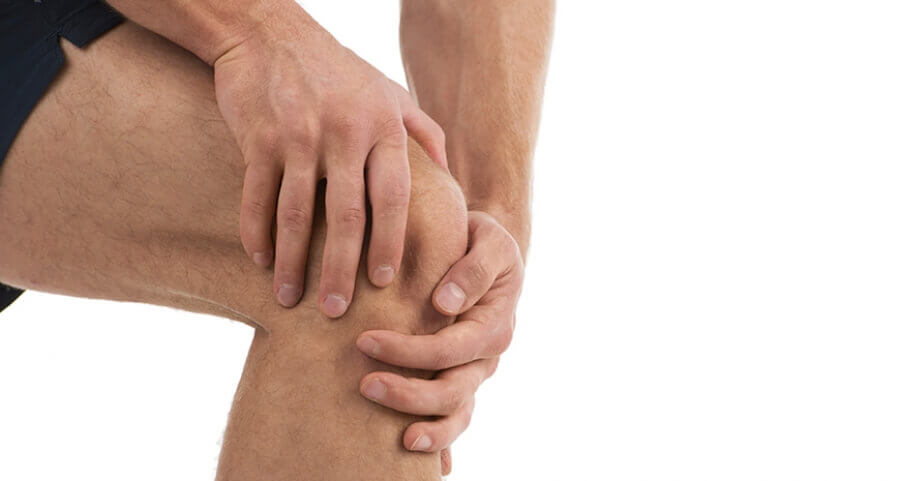Nearly 60% of patients who present with hip pain are due to a condition called trochanteric bursitis. This form of bursitis is more common in women and the middle-aged or elderly, than in men or younger athletes.
The hip joint is a ‘ball and socket’ joint, providing the functional link between the torso and the lower limb. Attaching around the hip joint are numerous large muscles, including the quadriceps (front of thigh) / hamstring (back of thigh), gluteal (buttock) muscles and the iliotibial band (ITB). On the outside of the hip joint there are a number of bursae (small fluid-filled sacs) that cover the greater trochanter of the femur (bony point of upper thigh bone) (arrowed). Their function is to provide cushioning in the spaces between the muscles, tendons and bones and to allow tendons to glide over bony prominences without friction when they move.
What Causes Trochanteric Bursitis?
Trochanteric bursitis occurs when the bursa becomes excessively ‘rubbed’ between the greater trochanter and the gluteus medius / iliotibial band tendons, causing it to become inflamed and painful. Both athletes and non-athletes can be affected by this hip condition and it is often caused by poor biomechanical loading of the lower limb. Possible causes include:
- Repetitive strain and mechanical trauma (more common), such as with abnormal patterns of walking / standing, poor pelvic stability (weak buttock muscles) or tight iliotibial band (outer thigh structures).
- Acute contusions (less common) as a result of trauma, due to either contact sports or falls in daily living.
Predisposing Factors
- An underlying degenerative arthritis
- Leg length discrepancy
- Poor lower limb gait patterns. For example, poor foot biomechanics may lead to increased internal rotation of the lower limb, tight hip adductor (inner thigh) and weak gluteal (buttock) muscles
- Poor trunk and pelvic stability
- Lumbar spine (lower back) pathology, such as intervertebral disc degeneration
What are the Symptoms?
- Insidious onset
- Pain on the outside of hip, often exacerbated by lying on the affected side
- Pain may extend down the outside of your leg towards your knee
- Pain with long periods of walking and / or sitting
- Pain at night may make it difficult to sleep
- Soreness or stiffness of the hip
- Can occur in both hips, with one worse than the other
- Pain with hip movements (i.e. pulling knee to chest, rotations of lower leg)
Conditions that Need to be Excluded
- Fractures, particularly if a significant trauma occurred and the individual is elderly and / or osteoporotic
- Lumbar spine (lower back) pathology, such as intervertebral disc (IVD) degeneration
These conditions will need to be excluded by a sports physiotherapist performing a thorough physical and biomechanical assessment to assess the extent of your injury. If there are any concerns of possible bone fracture or IVD injury, then further investigations are deemed necessary (i.e. x-ray, CT / MRI scans) to assist in providing an accurate diagnosis. If the physiotherapist is satisfied that the injury only involves soft tissue structures, then treatment can commence immediately.
What Can be Done?
The physiotherapy rehabilitation program is concentrated on immediate and correct management of the condition during the acute inflammatory phase. This will assist in speeding up your recovery, while also allowing the repair phase of healing to proceed as soon as possible, to enable a successful recovery and return to your daily activities / sport pain-free. This program may include:
- Rest: this will prevent the hip joint and its associated damaged structures becoming more sensitive and painful, and involves avoiding those positions and / or activities which aggravate the symptoms.
- Ice: regular application of ice will provide pain relief and minimize associated secondary soft tissue damage.
- Non-Steroidal Anti-Inflammatories (NSAIDS): will assist in minimizing the sensitivity, and thus the pain, of the bursa. These will need to be prescribed by your sports physician / general practitioner.
- Massage: plays an important role in restoring the normal muscle length of the tightened adductor / gluteal muscles, by improving local blood flow and releasing adhesions between the muscle fibres.
- Increase Pelvic Stability / Strength: by a series of graduated exercises to the muscles of the hip / thigh / pelvis. Often this is commenced in side lying, then progressed to weight-bearing as able.
- Stretching: poor gluteal / hamstring muscle flexibility can overload the hip joint and associated structures. Hence, a regular stretching program to maximize their length is essential for correct hip function.
- Correction of Pre-Disposing Factors: this ensures that the problem doesn’t re-occur and can include:
- Lumbar spine / hip joint mobilisations to ensure full movement and reduce any possible referred symptoms to the hip region.
- Education on correct training principles of duration, intensity and frequency for exercise, to ensure the hip can progressively adapt to the demands placed upon it without becoming exacerbated.
- Biomechanical factors such as over-pronation (flattening) of the feet can cause excessive demands on the joints and muscles of the lower leg. Wearing appropriate running shoes for your foot type will minimise these problems. An assessment by our sports podiatrist maybe appropriate to determine whether orthotics are required to assist with this stability.
- Cortisone Injection: can be a possibility when the above treatment has failed to provide complete resolution of the individual’s symptoms. A series of cortisone (steroid) injections maybe required to bring the inflamed bursa under control, and permit completion of the above rehabilitation program. This should be performed by a sports physician and / or hip orthopaedic surgeon (possibly under ultrasound guidance). Surgery is reserved only for extreme cases.


